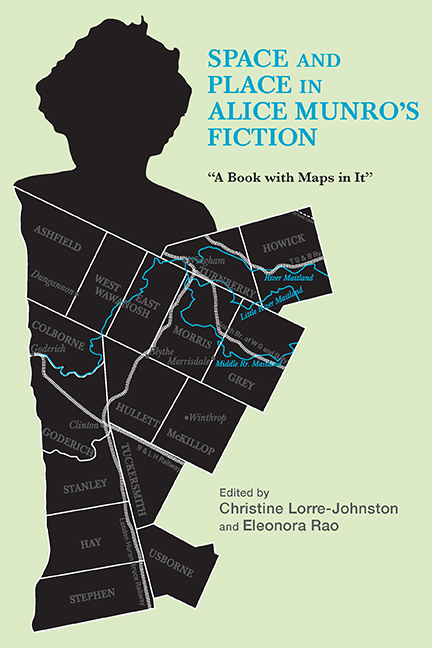Book contents
- Frontmatter
- Contents
- List of Illustrations
- Acknowledgments
- List of Abbreviations
- Introduction
- Part I Conceptualizing Space and Place: Houses, Landscapes, Territory
- Part II Close Readings of Space and Place
- 8 Spaces of Utopia and Spaces of Actuality in Alice Munro's “Jakarta”
- 9 Spatial Perspectives in Alice Munro's “Passion”
- 10 Charting Alice Munro's Terra Incognita: Punctuated Space in “Free Radicals”
- 11 Heterotopy in Alice Munro's “In Sight of the Lake”
- Bibliography
- Notes on the Contributors
- Index
11 - Heterotopy in Alice Munro's “In Sight of the Lake”
from Part II - Close Readings of Space and Place
Published online by Cambridge University Press: 15 August 2018
- Frontmatter
- Contents
- List of Illustrations
- Acknowledgments
- List of Abbreviations
- Introduction
- Part I Conceptualizing Space and Place: Houses, Landscapes, Territory
- Part II Close Readings of Space and Place
- 8 Spaces of Utopia and Spaces of Actuality in Alice Munro's “Jakarta”
- 9 Spatial Perspectives in Alice Munro's “Passion”
- 10 Charting Alice Munro's Terra Incognita: Punctuated Space in “Free Radicals”
- 11 Heterotopy in Alice Munro's “In Sight of the Lake”
- Bibliography
- Notes on the Contributors
- Index
Summary
IN THE “INTRODUCTION” to her Selected Stories (1996),1 Alice Munro writes almost apologetically about what, to her readers, has always appeared as a striking singularity of her work:
The reason I write so often about the country to the east of Lake Huron is just that I love it. It means something to me that no other country can—no matter how important historically that other country may be, how “beautiful,” how lively and interesting. I am intoxicated by this particular landscape, by the almost flat fields, the swamps, the hardwood bush lots, by the continental climate with its extravagant winters. I am at home with the brick houses, the fallingdown barns, the occasional farms that have swimming pools and airplanes, the trailer parks, burdensome old churches, Wal-Mart, and Canadian Tire. I speak the language. (SS, x–xi)
This pictorial excerpt is a piece of descriptive physical geography, inspected through the mutations in time produced by social advancement, as the occasional “swimming pools” and “airplanes” are meant to indicate. It is an aerially panoptical photograph of the country, deprived of any degree of aesthetic or historical evaluation but deeply permeated with emotional involvement. Munro's transparency of personal feelings is surreptitiously disclosed by means of specific stylistic strategies, mostly consisting in a poignant contiguity of contrasting terms (“at home” and “houses,” “brick” and “falling-down,” “barns” and “trailer parks,” “Wal- Mart” and “old churches,” “love” and “intoxicated,” and so on), unexpectedly wrapped up by the straightness of the final statement: “I speak the language.” It seems that the narrative use of a landscape requires the knowledge of its own language, a fact that, in Munro's case, may also refer to an otherwise untranslatable rendering of its overt or hidden life. Thus space, cultural geography, and language are all one.
Yet, Munro's intimacy with Huron County can also be imbued with the obsessions derived from its provinciality, to the point that, at some crucial stage of a life-journey, her characters are drawn to leave it behind, seeking to expand their minds in more promising locations, where a sense of displacement and a subsequent adjustment will take over, yet without their utterly abandoning the limited concerns of their domestic mentality.
- Type
- Chapter
- Information
- Space and Place in Alice Munro's Fiction“A Book with Maps in It”, pp. 199 - 208Publisher: Boydell & BrewerPrint publication year: 2018



